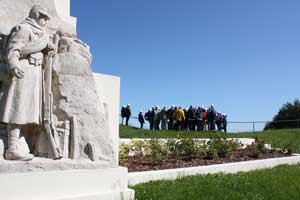
Visit
Live a unique experience of a battlefield where the mine warfare was conducted beyond imagination. Feel free to visit all by yourself only the surface battlefield, or register for a guided tour of the amazing underground network.

Discover
Discover the tragic destiny of a small village of the Meuse area, which used to stand at the top of a hill and disappeared in the 4-years-long battle between German and French sappers, following the explosions of 519 mines.

About us
The Association « les Amis de Vauquois » is only composed of volunteers.
Join us to support our efforts to maintain the battlefield, come to help our works team, or even become one of our guides. You are mostly welcome.
Welcome to the official website of the Association of Vauquois Hill |
|
Located about 30 kilometers West from the battlefield of Verdun, Vauquois Hill is a very special portion of the Western front of the Great War: a synthesis of all the kinds of horrors that occurred during the conflict. About 14,000 soldiers lost their lives during four years of battle for the control of its summit, a tiny portion of the Western front, 500 meters long, and the peaceful village eventually disappeared in the development of the mine warfare. Nothing was left from its church, its school and houses and the village has been replaced by a line of craters which cut the hill in two, as with a giant axe. A total of 519 explosions of mines were recorded (199 German, 320 French). As mine chambers were dug deeper and deeper in the hill, mines were loaded with increasing amounts of explosives: up to 60 tons! However, these impressive figures are not what makes Vauquois so special. Vauquois is neither the only village which was destroyed during the war, nor the only place along the Western front where mining techniques were used, as in the Argonne forest and other key observation positions, such as les Eparges, Massiges, Vimy, Messine, Hill 108 at Berry-au-Bac, or Hill 62 in Yper, etc. However, only at Vauquois can be combined the following topics : • the total destruction of a village by artillery and subsequent combats under the hill where it used to stand; • the integration of the combat trenches and galleries in a dense underground barracks network, with all the usual variety of assets (dormitories, field hospital, latrines, depots, power stations, air generators, command posts, communication centers,…), which are maintained in good shape and accessible to visitors; • the implementation of various techniques and systems in the conduct of mine warfare, leading each opponent to develop successive applications, with the aim to destroy the adversary’s positions, while denying his own projects. The association “les Amis de Vauquois” is tasked by the French State to maintain this site, which is recorded as a national monument, and present the vestiges that were found on the surface and in the underground networks. Throughout the year, the volunteers of the association guide visitors of all kinds, explaining the special circumstances of the combats for Vauquois, which eventually ended on Sep 26 , 1918, when the doughboys of the 138th and 139th US Infantry Regt, 35th US Division, captured the hill on the first day of the American Meuse-Argonne offensive. These few web pages don’t intend to detail all the operations which took place in this area. Our purpose is to help the reader understand why Vauquois Hill is worth a visit, as it stands now : a huge termites’ nest of about 17 km of galleries in the German underground barracks, and about 5 km of galleries under the French lines, and why this piece of land is still soaked of the blood of those who suffered and fell here, wherever they came from. One hundred years after the last combat, it is still time to pay tribute to them … all of them. Serge THIERION / Chairman of the association “les Amis de Vauquois” / April 2018 |

